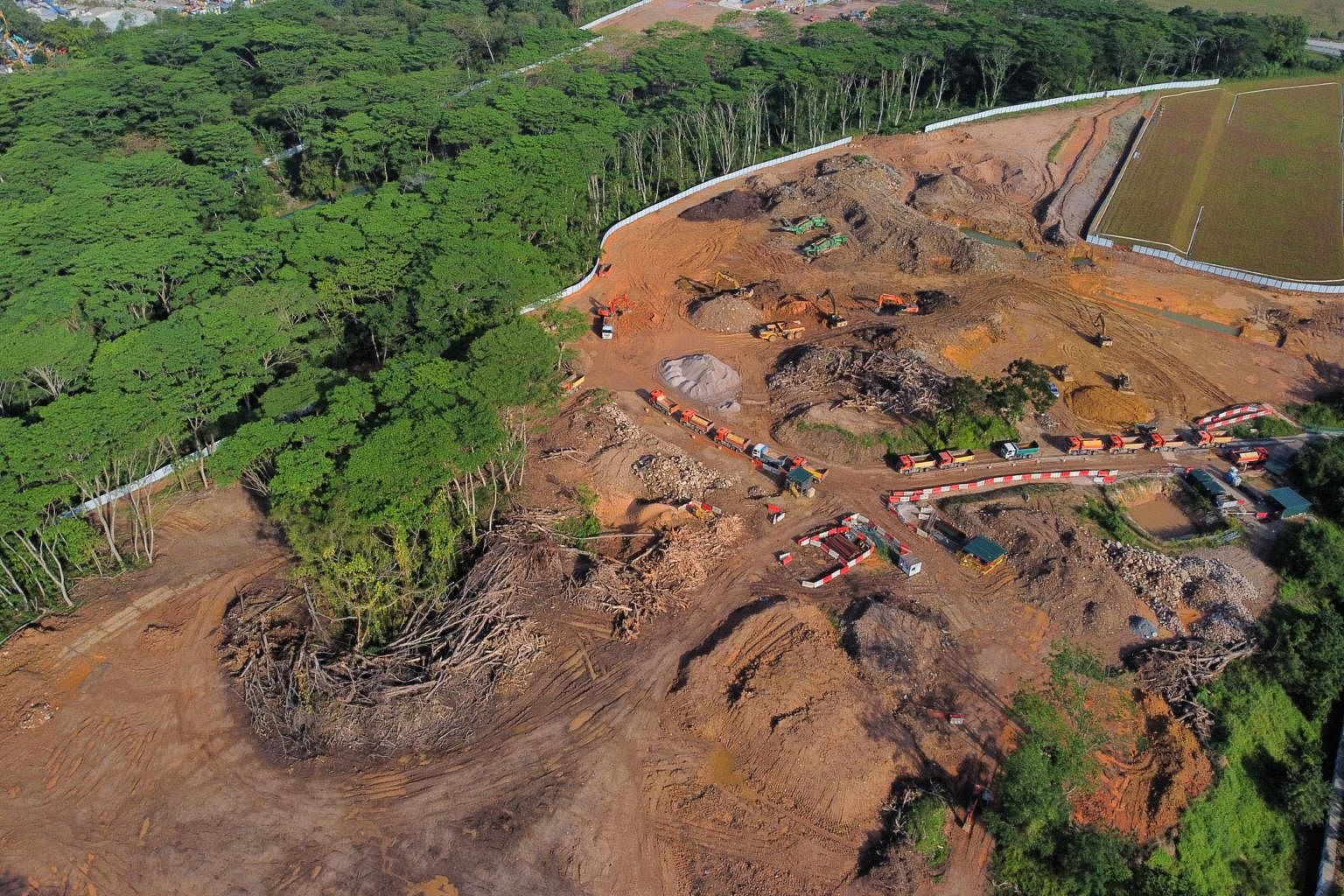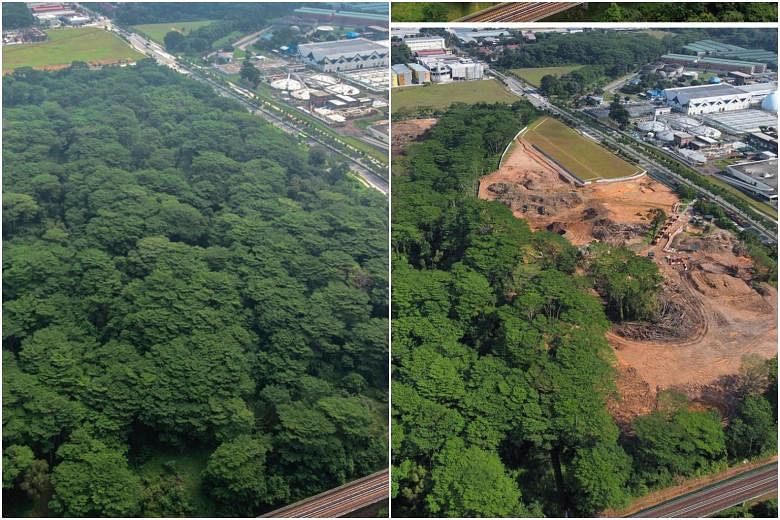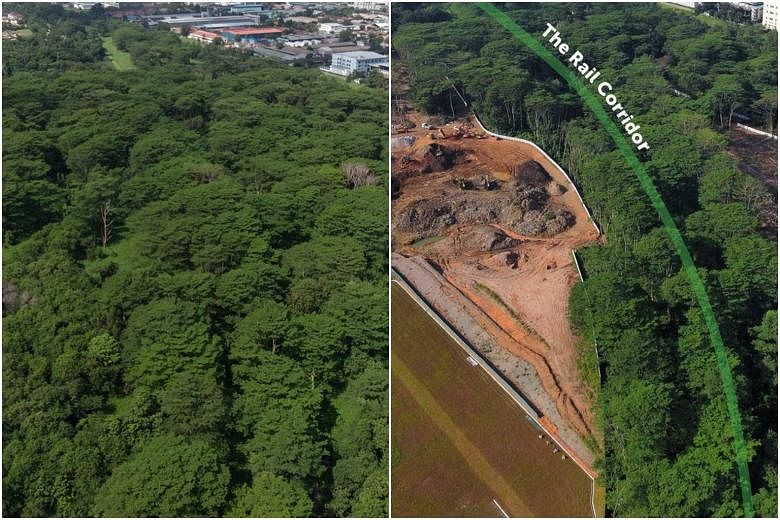SINGAPORE - Large swathes of Kranji woodland along the Rail Corridor were mistakenly cleared while the authorities were in the midst of biodiversity impact assessments there.
Aerial photos of the site showing the destruction of the woodland, a 70ha green patch home to around 40 species of birds, emerged on social media on Sunday (Feb 14). One picture showed a narrow strip of trees surrounding the Rail Corridor, with much of the rest cleared.
In response to these posts, a JTC Corporation spokesman said on Tuesday that the land was "erroneously" cleared by its contractor before the completion of environmental assessments.
The National Parks Board told The Straits Times that it is investigating the unauthorised clearance at the site.
"We take a serious view of unauthorised greenery clearance and will not hesitate to take the appropriate enforcement action," it added.
Development projects in Singapore near sensitive nature areas are subject to greater scrutiny and may be required to carry out more detailed environmental studies.
Beginning at the end of last December, green patches were cleared on the site, slated for the Agri-Food Innovation Park, which is part of the Sungei Kadut Eco-District (Sked). The master plan for the latter, which seeks to support new growth sectors such as agri-tech and environmental technology, was announced in February last year.
Upon discovering the mistake during a site inspection on Jan 13, JTC instructed the contractor, Huationg, to stop all clearing works immediately.
No further clearing has taken place at the site since then and the contractor has been issued a stern warning, JTC said.
According to the statutory board, it had engaged an environmental specialist to conduct a biodiversity baseline study last December to create an environmental monitoring and management plan (EMMP) for specified plots of land within the area. These were expected to be completed around April before plans to engage stakeholders.
"JTC will continue with the baseline study and EMMP and will work closely with all relevant stakeholders... to ensure the Sked redevelopment plans are carried out with due consultation and in an environmentally responsible and sensitive manner," the spokesman said.
"The findings of the studies will be publicly available when ready."
In a statement, Huationg apologised and said it was working with JTC on investigations "to determine the cause of this lapse, and to prevent future occurrences".
"We are also reviewing internally and working with JTC to strengthen our project management processes," the contractor added.
'Shocking and dreadful'
Members of the nature community were shocked by what had happened.
Mr Brice Li, who posted the photos, said: "My heart sank when I saw that around 40 to 50 per cent of the area was gone."

Upon receiving a phone call about the situation, the creative art director visited the site to survey the damage on the first and second day of Chinese New Year.
"I usually share photos and videos showcasing the beauty of places but this was too much for me not to show," added the nature lover who had shot a video of the woodland in May 2019.
"This was a... human error that could have been avoided," he said.

On Monday, Nature Society Singapore (NSS) commented in a Facebook post that this was a "shocking and dreadful development".
"It's a huge oversight... We lost a sizeable natural habitat and a picturesque space for hikers along the northern sector of the Rail Corridor," said NSS conservation committee chair Leong Kwok Peng.
This will likely affect the ecological significance of the Rail Corridor, but the impact can be fully understood only with an environmental impact assessment, said environmental consultant Tony O'Dempsey.
"If we take out the destinations that the Rail Corridor connects to, it has less utility as a corridor," he added.
Moving forward
Nature lovers recommended retaining the woodland as part of the design for the redevelopment.
The Kranji woodland is unique because it forms a direct connection between the mangrove-lined Sungei Pang Sua tidal canal and the Rail Corridor, said Mr O'Dempsey.
Birds and bats, which use the woodland for nesting and roosting, are important seed dispersers that contribute to the area's biodiversity.
"This would be a crowning feature of the (Sked) development, bringing some heart to the built environment," he added.
"We would have proposed a bigger width for the green buffer on both sides of the Rail Corridor and that the Kranji woodland be merged with Sungei Pang Sua as a single habitat," Mr Leong said, adding that wildlife tends to be richer with a water body.
"I am confident that whatever damage has been done can be restored... though it could take over a decade or so," said Mr O'Dempsey.



